The history of Austria's modern parliamentary systems begins in 1848. However, it is 26 February 1861 and the so-called "February patent" which can be considered the Austrian Parliament's true hour of birth. It was this constituonal law which provided for a parliament in Austria, then called "Council of the Realm" (Reichsrat). Except for some periods of intermission this institution existed up to 1918 when monarchy came to an end.
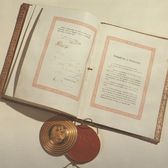
While the February Patent was billed as a "Constitution of the Realm", with the exception of a guarantee of the rights of citizens, it lacked essential components normally found in a constitution, such as provisions on the executive and judicial branches, ministerial accountability or parliamentary immunity.
The Reichsrat was a bicameral decision-making body. The first chamber, the House of Lords (Herrenhaus), was composed of the princes of the imperial dynasty as soon as they were of age, the heads of the Austrian landed aristocracy whom the Emperor awarded hereditary membership in the Reichsrat, the archbishops and prince-bishops, and men who were appointed life peers on account of their achievements in public life, the Church, or the arts and sciences. The presidents and vice-presidents of the House of Lords, as well as the presidents and vice-presidents of the second Reichsrat chamber, the House of Deputies (Abgeordnetenhaus), were appointed by the Emperor.
The House of Deputies was to be composed of 343 members who would form an "Enlarged Council of the Realm" encompassing representatives of the Hungarian crownlands.
Yet continuing conflicts between the nationalities, and the fact that only a minority of provinces had deployed delegates to the Reichsrat, forced the Emperor to repeal the Basic Law on the Representation of the Realm on 20 September 1865. The Reichsrat did not convene again until after the Compromise (Ausgleich) was concluded between Austria and Hungary in 1867.
At first there was no adequate venue for the parliament created by the February Patent. Only in 1874 did construction begin on Theophil Hansen's design for a monumental parliament building. Until then, the House of Lords held its sessions in Lower Austria's Landhaus on Herrengasse, and a makeshift building, soon to be disparagingly referred to by the Viennese as "the wood shack" was put up for the House of Deputies on today's Schottenring.
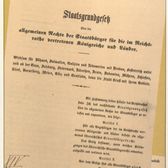
Austria's defeat in its war with Prussia in 1866 and a government reshuffle early the next year created a favourable climate for the granting of the autonomy long coveted by the Hungarians, in the context of a dualistic system of state organisation. Conversely, this necessitated the creation of a constitution for the kingdoms and lands remaining within the Austrian Reichsrat.
In June 1867, Emperor Francis Joseph I sanctioned the statutory provisions regarding the Compromise. In December, he also approved the concurrent provisions for the Austrian part of the realm. Relations between Austria and Hungary had been given a new form, which was to last until 1918. The kingdoms and lands represented in the "Austrian" Reichsrat were united with the provinces of the Hungarian crown by the fact that a monarch (the Emperor of Austria and King of Hungary) was common to both. "Pragmatic joint affairs", i.e. foreign affairs, war and army matters and financial affairs (where joint expenses needed to be covered),- came under the terms of the Compromise laws.
The Basic Laws of the State of December 1867, which in their entirety were referred to as the "December Constitution", can be considered a fully fledged constitution for the Austrian part of the realm. To begin with, the Basic Law on the Representation of the Realm, issued on February 1861, was amended to conform to the changed conditions.
As already stipulated by the February Patent, the Reichsrat in Vienna continued to consist of the House of Lords and the House of Deputies. The terms of reference of the Reichsrat in Vienna included all matters which were the common concern of the provinces represented in the Reichsrat. The budget became a concern of the Reichsrat as well. For the first time, the Austrian parliament was entitled to vote annually on taxes already in force. The presidents and vice-presidents of the House of Lords were still appointed by the Emperor, whereas the House of Deputies was entitled to elect its presiding officers on its own. In contrast to the February Patent which did not provide for parliamentary immunity, the December Constitution of 1867 decreed the immunity of the members of the Reichsrat. Ministerial accountability, desired by parliament since 1861, was finally achieved as well, although it merely related to commissions or omissions of ministers by which either the constitutions of the realm or of a province or simple laws had been infringed upon. A two-thirds majority in one of the houses was required to impeach a minister before the Supreme Court of the Realm. With respect to the Emperor, the Basic Law of the State on the Executive and Administrative Powers continued to provide: "The Emperor is sacrosanct, inviolable and not accountable. The Emperor exercises his administrative power through accountable ministers. The Emperor appoints and dismisses his ministers ..."
The years 1873, 1882, 1896 and 1907 saw further reforms, which evolving gradually mainly concerned electoral law. Notwithstanding until the collapse of the Monarchy, suffrage was only granted to men.The House of Deputies was again elected directly as of 1873, with six-year legislative periods.

The attempt of the last Austrian Emperor, Charles I, just a few weeks before the end of the war, to initiate with his "Völkermanifest" of 16 October 1918 the transformation of the Austro-Hungarian Monarchy into a Central European federal state, was doomed to failure from the start. However, his call for the establishment of "National Councils" found willing ears, not only in Prague and Zagreb (then called Agram), but also in Vienna, where the deputies of the German-speaking Reichsrat constituencies met on 21 October in the Landhaus of Lower Austria on Herrengasse as the "Provisional National Assembly for German Austria".
In its second session on 30 October, the Provisional National Assembly assumed "supreme power over the State of German Austria", a state which, according to the intentions of its founders, was to comprise the German-speaking parts of the disintegrating monarchy, in particular those of the crownlands Bohemia, Moravia and Austrian Silesia. Social Democrats, Christian Socials and German Nationalists formed a joint provisional government headed by the Social Democrat Karl Renner as State Chancellor.
What remained open on 30 October 1918 was the form of government to be adopted. The question was finally settled after Emperor Charles I had renounced any participation in government.The Republic was proclaimed on 12 November.
The conclusion of the Peace Treaty of Saint-Germain in 1919 shattered all hopes of integrating the German-speaking regions of the former crownlands into the young republic and decisively defined its national borders. The new state was now called the "Republic of Austria".
For the purpose of drafting a constitution, a Constituent National Assembly was to be elected by proportional suffrage, a novelty for Austria, and by "universal, equal, direct and secret ballot of all citizens without distinction of sex". The first elections in the Republic of Austria were conducted on 16 February 1919. The Constituent National Assembly was composed of 170 members. Its principal task was the drafting of a definitive constitution.
The Subcommittee of the Committee on the Constitution of the Constituent National Assembly was set up on 8 July 1920 and deliberated on the basis of different drafts for the rest of the summer. On 1 October 1920, the Constituent National Assembly unanimously adopted the Federal Constitution (B-VG) of the Republic of Austria on the third reading. However, it proved impossible to achieve consensus on a number of points, with the result that the constitutional document had to remain incomplete. The catalogue of fundamental rights was taken over from the 1867 Basic Law of the State on General Civil Rights.
This Constitution established the Austrian state as a parliamentary republic with a federal structure, with provincial assemblies (Landtage) as the legislative bodies of the federal provinces and a bicameral parliament at the federal level. This comprised the National Council, to be elected by direct ballot, and the Federal Council, whose members are elected by the provincial assemblies. The latter was to participate in federal legislation as the chamber representing the provinces.
Contrary to the present, the Federal President was to be elected not by direct popular vote but by the Federal Assembly. The Federal government was to be elected by the National Council, on whose confidence it depended. The "legal accountability of ministers" established in 1867 was now complemented by the "political accountability of ministers" in the Republic of Austria, i.e. the government of the day was made dependent on the political will of the representation of the people.
A significant modification of the Constitution was undertaken as early as in 1929, when the second major amendment to the Federal Constitution was adopted. Modelled on Germany's Weimar Constitution, it enhanced the separation of powers by adding greatly to the powers of the Federal President as a countervailing force to the parliamentary power. The Federal President, whose democratic standing was enhanced by direct popular election, was given the powers to dissolve the National Council and convene and adjourn its sessions, to appoint and dismiss the Federal government, to issue emergency decrees and to act as supreme commander of the federal army. Still, in exercising these powers, or nearly all of them, the Federal President depended on proposals by the Federal government, which in its turn was dependent on the confidence of the National Council.
Ever since their coalition had foundered in 1920, the major political groupings - the Christian Socials and the Social Democrats - had been confronting each other with increasing hostility. Their hostility was not only reflected in parliamentary arguments but it found its most vivid expression in the streets, in clashes involving the paramilitary forces which both sides had established. The first bloody climax came on 15 July 1927, when a controversial court decision gave rise to a mass demonstration in front of the Palace of Justice. After the building was set on fire, the police used violence against the demonstrators and 90 people lost their lives.
The Christian Social Party remained in power thanks to a variety of coalitions with the Pan-German Party and the Landbund (Rural Federation, another political party). Their 1931 offer to the Social Democrats to join in a coalition was rejected. Over time, an increasing number of Christian Social Party members were convinced - and gave vocal expression to their opinions - that the rise of National Socialism, which was manifest especially after the provincial elections of 1932, could best be combated by an autocratic form of government and the elimination of democratic opposition.
By way of summary, it may be said that the brief phase of co-operation between the Social Democrats and the Christian Socials, which ended as early as in 1920 after the adoption of the Federal Constitution, was followed by intensifying ideological strife. The struggle between political cultures that characterised the interwar period increasingly split the political factions, soon rendering the ideological contrasts between the opponents all but insurmountable. In particular after the Great Depression of the late 1920s and early 1930s had reached Austria as well, anti-democratic ideas gained in popularity, as in other European countries.
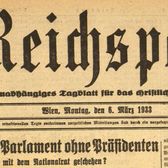
In 1933, the National Council's incapacity to act - a state of affairs that under a more normal political climate in Austria would have proven ephemeral - was defined as its "self-dissolution" by the Federal government, which claimed that this entitled the government to act on its own, without popular representation, merely on the basis of decrees.
What had happened? On 4 March 1933, all three presidents of the National Council resigned following a controversial vote. At the time, the Standing Orders of the National Council made no provision for such a situation, although a solution could certainly have been found if democratic goodwill had been exercised. Basically, any official who is dismissed or resigns normally continues to hold his or her office until a successor has been chosen, in order to safeguard an orderly transition.
As the "acting" President, the Third President in fact tried to reconvene the National Council on 15 March 1933. However, with the agreement of Federal President Wilhelm Miklas, the Federal government, using the police force, prevented this session. That the National Council did not consider itself dissolved is also demonstrated by the fact that a session of the Main Committee took place on 8 March. The Federal Council, likewise a legislative body, also tried to reconvene the National Council.
The government of Chancellor Engelbert Dollfuss had already resolved to govern by decree for a certain period in order to impose a constitutional reform and a fundamental revision of the Standing Orders of the National Council on the Social Democratic opposition. In the wake of the German Reichstag elections on 5 March, which had resulted in a relative majority for the National Socialists, the intention was to enforce far-reaching powers of emergency decree government and other powers ignored by the 1929 constitutional reform. In the course of 1933, Dollfuss gradually abandoned the idea of returning to a parliamentary system in the democratic Western European tradition. The events surrounding 12 February 1934, which triggered a short but violent civil war in Austria, further shifted the powers of government towards the autocratic forces. This was strongly supported by Italy, which, governed by Mussolini and at the time Austria's only effective ally against National Socialism, favoured an autocratic and anti-democratic solution. All this occurred against the background of growing conflict with Nazi Germany, which the Dollfuss government hoped to counter successfully with a corporative, autocratic constitution and the formation of a new unity party, the Vaterlandische Front (Fatherland Front).
Surprisingly, the authoritarian corporative regime was interested in investing its new constitution with a pseudo-legal appearance. The National Council was again convened on the basis of a War Economy Ordinance on 30 April 1934, albeit only as a rump parliament, since the Social Democratic MPs had been deprived of their seats. In this session, the National Council adopted the Empowering Act of 1934, which transferred ordinary and constitutional legislation to the Federal government without restrictions or limitations, in particular enabling it to promulgate the Constitution of 1934.
In its preamble, the new Constitution defined Austria as a "Christian, German federal state on a corporative basis". The words "republic" and "democracy" were avoided, as the democratic basis had been supplanted by an authoritarian one, i.e. the people were now represented by the government and the bodies appointed by it. With respect to legislative bodies, the people as a uniform electoral body was supplanted by cultural and professional associations. The representatives delegated by these were to be assisted by a number of appointed "virilists". However, all representatives were granted only restricted rights of political participation in policy formation compared to the democratic parliamentary system. The National Council and the Federal Council were replaced by four "deliberative bodies", as they were called (Staatsrat, Bundeskulturrat, Bundeswirt-schaftsrat and Landerrat), as well as by the Bundestag and Bundes-versammlung as decision-making organs. Apart from curtailing the typical competences of classic-style parliaments, such as determining the substance of legal provisions or submitting initiatives, the Federal government and the Federal President were now granted extensive powers of governing by emergency decrees. Moreover, the Constitution of 1934 provided for a plebiscitary element that enabled the government to outmanoeuvre the legislative branch.
As a result of the Constitution Transition Act of 18 June 1934 and the Empowerment Act of 30 April 1934, the Constitution of 1934 remained a largely theoretical document. In the period from 1934 to 1938, close to 70 per cent of all laws were directly enacted by the Council of Ministers without consulting the Bundestag or its deliberative bodies. Moreover, the concept of professional corporations was largely ignored. Until 1938, the authoritarian system of government thus remained predominant. Further consequences of the new Constitution were the prohibition of political parties and the stipulation that the Fatherland Front was to be the sole state party. This expressly forbade any form of opposition to government, suppressed the free competition of political ideas, and prevented any direct expression of the will of the people.
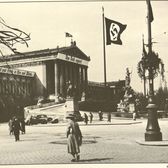
The occupation of Austria by Hitler's troops entailed the Anschluss, the country's annexation to the German Reich. The referendum held in April 1938 was a mere sham - the dictatorial situation made a negative result inconceivable, and even if the population had decided otherwise, the die was cast in any case. According to the official German position, the Anschluss meant that the state of Austria had utterly disappeared as a subject under international law, without leaving a legal successor.
Adolf Hitler had seized power in Germany on 30 January 1933. The NSDAP immediately was declared the sole party and, as"bearer of the German state concept, inseparably linked to the German state" (Law Gazette of the German Reich I,106).
With the approval of 444 of 647 Reichstag members, the Empowerment Act adopted by the German Reichstag on 24 March 1933 ("Act to Remedy the Distress of People and Reich"), assigned all legislative powers, including constitutional legislation, to the federal government. The territorial rights of the German states (Lander) were also transferred to the government. As a result, not only the parliaments of the Lander but also the representation of the Lander at the federal level (the Reichsrat) were suspended as superfluous (Act of 14 February 1934). After the death of the German president, Paul von Hinden-burg, the functions of chancellor and president were combined (Act of 1 August 1934).
Hitler now served in both capacities. All forms of a separation of powers were abolished in the German Reich, the only authority being the Fiihrer. While the Reichstag continued to exist at a purely formal level, all its competences had been transferred to the Fiihrer and his government. The Reichstag merely served as a forum for Hitler's policy statements or to give solely declarative endorsement to specific bills. Its members were de facto appointed by the Chancellor. In all, the share of laws enacted in the 1939-1945 period decreased drastically: only some 10 per cent of statutory acts of the state were laws, with the remainder made up of directives personally issued by Hitler (decrees, orders, ordinances, instructions and dispositions) (Blanke 2003,44).
While work on a new constitution for the Third Reich (as of 1938, Greater German Reich) had initially been undertaken, it was never completed, since "the Fuhrer, himself embodying the law, was not bound by any (written) law" (Blanke 2003,43).
For Austria, the Anschluss meant becoming an administrative district of the German Reich. In mid-March 1938, the Federal government was replaced by the Reichsstatthalter (governor) and the Austrian provincial government. On 23 April 1938, these were subjected to the directions of the"Reichskommissar for the Re-unification of Austria with the German Reich", who in his turn was directly answerable to the Fuhrer. As a result, all legislative organs provided for in the Constitution of 1934 were abolished without substitution; the only applicable law was that issued by the "Governor (Austrian Provincial Government)".
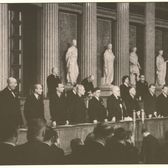
As in 1918, when the First Republic was founded, the emergence of the Second Republic in April 1945 was brought about by the political parties. This time, however, the parties did not become active within the framework of a parliamentary body, although Karl Renner, once again the leading political force, briefly toyed with the idea of trying to convene those National Council members elected in 1930 who were still alive. The political constellation, too, was different from 1918: the Socialist Party (SPÖ) and the conservative People's Party (ÖVP) were joined by a third "anti-Fascist" party, the Communist Party (KPÖ). On 27 April 1945, only a few days after the liberation of Vienna by Soviet troops, representatives of the three anti-Fascist parties published a "declaration of independence" in which they proclaimed the restoration of the democratic Republic of Austria. The Pan-German camp was discredited by the events of the Nazi era and re-emerged politically in 1949.
On that same 27 April 1945, a Provisional State Government was formed and headed, as in 1918, by Karl Renner. The aim was to reinstate the Federal Constitution of 1920 as amended in 1929, as well as all other provisions of federal constitutional law in force on 5 March 1933. Until the convocation of a freely elected parliament, the Provisional Constitution of 1 May 1945 entrusted legislative power to the Provisional State Government. This, the last instance of legislation by decree in Austrian constitutional history, was actually intended for no more than a period of transition and clearly seen as a step to paving the way for the return to democratic order.
At first, the Provisional State Government was only recognised by the Soviet occupation force. When it was finally recognised by all federal provinces and the four Allied Powers, the road was clear for national elections on 25 November 1945. The outcome surprised many: The ÖVP achieved absolute majority with 49.8 per cent of votes, followed by the SPÖ with 44.6 per cent of votes, while the KPÖ attracted a mere 5 per cent of voters. On 20 December, a joint government of all three parties, headed by Federal Chancellor Leopold Figl (ÖVP), was sworn in.
When the newly elected National Council met on 19 December 1945, the Federal Constitution of 1920 as amended in 1929 again entered into force, but with one important qualification: the provisions regarding the Provincial and Corporation Council (Länder- und Ständerat), which had never taken effect, were replaced by the constitutional provisions concerning the Federal Council as in force prior to 1929.
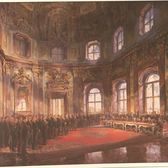
Although the parliamentary system was thus reinstated and vested with national legislative powers, these powers could not be fully exercised since the Republic of Austria, still under Allied occupation, was not yet a sovereign state. Initially, legislative decisions required approval of the Allied Council before enactment. As of mid-1946, such approval was only required for constitutional acts, while simple laws could be promulgated unless objected to by the Allied Council within 31 days. Since the Allied Council decided by unanimity, Austria in fact had relatively broad legislative powers, which at least prevented a paralysis of the Austrian legislative process. It was only with the State Treaty of 15 May 1955 that the Republic of Austria regained its full sovereignty.
The constitutional framework for the exercise of the policy-making and legislative powers remained essentially the same over the following decades. There have been two basic reforms of the law governing National Council elections. The National Council Electoral Law of 1971 improved the implementation of the principle of proportional representation by creating a slightly more favourable situation for small political parties. The second reform, undertaken in 1992, strengthened links between the electorate and the elected, at the same time further refining the implementation of proportional representation. Since 1971, the number of National Council members has been 183; it had been 165 before the reform. The powers of the Federal Council were broadened to a degree. Most important, since 1984, any change in the distribution of competences at the federal level working to the disadvantage of the federal provinces has been subject to approval by the Federal Council.
The development of the parliamentary system in the Second Republic can be divided into seven phases (see Fischer 1997,100-101):

The first two decades of the Second Republic were characterised by an effort to avoid the mistakes made in the First Republic. Co-operation was a key goal. The two large parties, the SPÖ and the ÖVP, accounted for more than 90 per cent of votes in the National Council. The government could rely on an overwhelming majority in Parliament, which enabled it to take legislative decisions to change the Constitution. In this period, the parliamentary system could develop only to a limited extent, as the opposition was too weak to exercise effective control. Policy formation was largely relegated to pre-parliamentary negotiations in the context of social partnership.
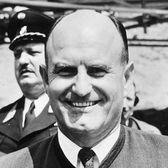
For the first time government was faced with a strong parliamentary opposition. Laws amending the constitution could only be adopted with the opposition's approval. Likewise, the possibilities of parliamentary control were first applied effectively.
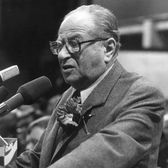
It was an exciting year in terms of the parliamentary system, because the government was initially able to push decisions through Parliament only if seconded by at least one party in opposition. The SPÖ found consensus with the FPÖ, which accordingly voted for the budget. To this end, electoral law had to be amended to improve the chances of smaller parties' winning seats in Parliament (the number of seats in the National Council was increased from 165 to 183, and National Council election rules were changed to the advantage of smaller parties).

In this period, too, the parliamentary opposition enjoyed greater opportunities to exercise control over the government. Once again the government needed the support of the opposition to amend constitutional laws. Nevertheless, many laws were unanimously adopted. Co-operation within the context of social partnership prevailed, which meant that conflicts were settled before reaching the stage of parliamentary debate. While the spirit of co-operation was very intensive, it was largely restricted to the SPÖ and ÖVP.
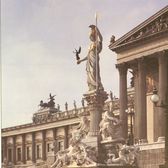
The SPÖ's loss of its absolute majority in 1983 led to a time of new coalition governments - in very different constellations, including SPÖ-FPÖ, SPÖ-ÖVP and ÖVP-FPÖ/ÖVP-BZÖ.
While the intensity of parliamentary debates increased during this period, they remained solidly anchored in a democratic base. The Austrian parliamentary system has gained in importance with the new political constellation. Both ordinary and extraordinary sittings of the National Council are watched by more and more citizens, since they are often broadcast on television and commented on in detail.
In addition to these domestic policy developments, Austria's accession to the EU on 1 January 1995 entailed a fundamental change in the country's constitutional order and policy-making system. As a supranational organisation, the EU, within its range of competences, claims an autonomous legislative power that takes precedence over national legislation.